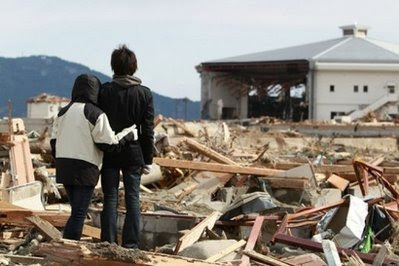Help for the People and Animals of Japan
The nation of Japan is in the midst of its worst crisis since World War II, and it began with a massive 9.0 earthquake which then spawned a deadly tsunami. The earthquake and tsunami have wrought almost unimaginable destruction, including an unfolding drama with the severely damaged Fukushima nuclear power plant now hemorrhaging radioactive elements into the atmosphere.
We feel for the human victims of this cataclysm. We of course also feel for the countless thousands of animal victims.
Humane Society International, our global arm, is in touch with Japanese animal protection organizations, helping to assess and to anticipate animal-related needs. In the days and weeks ahead, we’ll do all that we can to help them, with financial support, personnel, and technical assistance.
AP Photo/The Yomiuri Shimbun, Daisuke UragamiA family with their dog at a shelter in Japan.
Our disaster response team is in the Philippines, waiting to deploy, and coordinating our contact with Japanese groups. When we have properly assessed the risks and complications that increased radiation levels from the nuclear plants might pose for successful deployment, we’ll send field responders to the stricken zone.
One Japanese correspondent tells us, “The local media reported running into a man walking through the rubble. He said he was looking for his wife…and when the reporter looked again a small Chihuahua was peeking out from under his overcoat. ‘I ran as fast as I could with him and the cat, but the cat got lost in the turmoil...’ were his words.”
Japan has a growing humane movement, and some prior experience with pet evacuation and related challenges. Its government has understandably applied rather strict controls on who can or cannot enter the disaster area and as things are shaping up, a few key groups are working to set up a supply system to support shelters and people in the affected region.
Both The HSUS and HSI plan to provide expertise and funding to support rescue and response efforts in the crisis, and to lay the groundwork for the restoration of animal care in the devastated communities in the longer term.
This is the approach we’ve taken in Haiti, since the January 2010 earthquake there, and in the Gulf States, afterHurricane Katrina struck in 2005. In both instances, our initial deployment represented just a first step toward long-term investments of money, expertise, and personnel, which continue to this day. As a donor to our international disaster fund, you’ll help to secure the same result in Japan.
It is not lost upon any of us at HSUS that the government of Japan has been no ally of animal protection, launching commercial whaling boats throughout the Pacific and Antarctic Oceans, fighting wildlife protection proposals at international conventions, and generally not evincing much sympathy for the cause of animal protection. But today, more than ever, we are allies of the island nation, and we send our prayers to the suffering people and animals inhabiting the country. We will be sending help in days and weeks and months ahead.
The animals associated with this organization aren't victims -- they are the heroes. Search dogs are an integral part of any rescue effort. According to theSearch Dog Foundation, "After a disaster, when buildings have crumbed to the ground, dogs can search much more quickly and safely than people can."
These dogs are highly trained to find victims who would otherwise remain buried, as they are able to "crawl through tunnels, walk up and down ladders, and walk on wobbly surfaces and over debris and rubble." Currently 21 SDF canine disaster search teams have deployed in Japan to search for victims in the destruction.
You can support them by sponsoring a search dog.
These dogs are highly trained to find victims who would otherwise remain buried, as they are able to "crawl through tunnels, walk up and down ladders, and walk on wobbly surfaces and over debris and rubble." Currently 21 SDF canine disaster search teams have deployed in Japan to search for victims in the destruction.
You can support them by sponsoring a search dog.
Source
Source
http://hsus.typepad.com/wayne/2011/03/japan-disaster.html






























 A photo sent out via Twitter showing the destruction in northeast Japan. The accompanying message read: “This is my house on the left. It washed away by the tsunami. I don’t think I can attend school from this spring.”
A photo sent out via Twitter showing the destruction in northeast Japan. The accompanying message read: “This is my house on the left. It washed away by the tsunami. I don’t think I can attend school from this spring.”